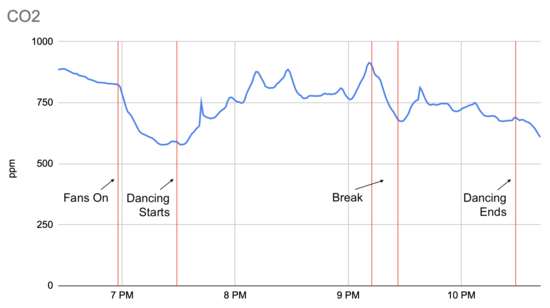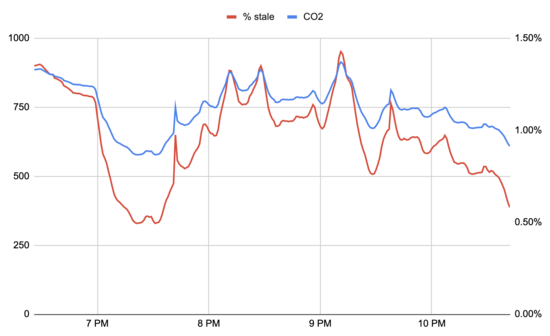BIDA Air Quality Measurements |
May 16th, 2022 |
| airquality, contra, covid-19 |
I recently got a Temptop M2000, which measures CO2, as well as particle levels (pm2.5 adn pm10) and HCHO (formaldehyde). I got it because I'm interested in running some tests on my ceiling fan air filter idea, but now that I have it I want to measure everything. It logs to one minute intervals, and you can export to CSV.
The dance is in the basement of the Cambridge Masonic Hall, and the main room is 66x48 (3200 sqft) with about a 25ft ceiling (80,000 ft3). There are four ceiling fans which we keep on high. We have two large barrel fans, rated for 15,000 CFM on high. We put one blowing in at one end, and one blowing out at the other. In theory that might give us 11 ACH (60 min/hr * (80k ft3 / 15k ft3/min)) but I would expect to see lower performance than that: there are various obstructions, and there is nothing to stop air coming back in around the fan (the opening is not sealed around it).
Here's what I measured, with the monitor in a back corner where I expect the air is most stale:
These readings makes sense:
- The air was initially pretty stale when we got there
- Turning the fans on had a strong effect
- Dancing had an even larger effect in the other direction, presumably through people breathing more heavily.
- Decrease during the break, when people aren't dancing.
- Increase after the break, but not as large because dancers generally start leaving at the break and during the second half.
Here's another way to look at this: since atmospheric CO2 is 400ppm and exhalation is 40,000ppm, we can look at how stale the air is on a continuum that runs from "outdoors" to "literally breathing only someone's exhalation". This is (CO2-400)/(40,000-400). Two people having a meeting in a small room with conventional office HVAC gives you ~1000ppm or 1.5% stale, and I'm going to use this as a benchmark for "standard indoor air quality". This dance ranged from 0.5% to 1.5%, so I would say our ventilation was successful at keeping us from going above standard indoor exposure despite the number of people and active movement.
The biggest problem with these measurements is that last night's dance was unusually small: with higher covid rates and us now requiring high-filtration masks we had ~85 people, compared to recent dances with ~190 and pre-pandemic dances with ~130. I definitely want to repeat this a future dance with more typical attendance.
Comment via: facebook, lesswrong, substack

